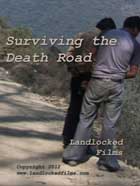
Surviving the Death Road 2012
Distributed by Landlocked Films, LLC, 1505 Mariposa Ave., Boulder, CO 80302; 303-447-2821
Produced by Beret E. Strong & John Tweedy
Directed by Beret E. Strong & John Tweedy
DVD , color, 48 min.
Sr. High - General Adult
Bicycling, Cultural Conflicts, Developing Countries, Latin American Studies, Modernization, Sustainability, Travel and Tourism
Date Entered: 07/18/2013
Reviewed by Rob Bohall, George Fox UniversityUsing personal interviews interspersed with stunning footage, this highly accessible film contrasts two very different populations who make use of the same notoriously dangerous road high in the mountains of Bolivia: (1) bike-riding Western adventure tourists, and (2) the impoverished Bolivians in whose rural towns they drink and celebrate.
Known as “the deadliest road in the world” due to the high number of traffic fatalities that occur annually on its sharp curves and narrow passes along vertigo-inspiring sheer faces, the Death Road attracts groups of wealthy young European and American thrill-seekers on mountain bikes pursuing an "easy adrenaline rush" and a good story as they descend thousands of feet.
Local store owners struggle to make a living selling to the truck drivers and tourists who use the road, hoping to earn enough to survive and possibly enable their children to get an education and escape generational poverty. They complain that the bikers stop only to drink beer there, leaving behind trash but buying nothing else.
The prejudices of each group toward the other come through, but the wide cultural gap is not the focus. Rather, the central theme of the film is the challenge for traditional local people to adapt to change and embrace modernization in order to survive.
The business side of adventure tourism companies are explored through interviews with company owners in the U.K., including how they market through shaping perception of the road as extremely dangerous, but the guided trip itself safe and unforgettable.
Thankfully, the film avoids being overly heavy-handed or biased (as in Oliver Stone’s South of the Border, 2009) by demonizing the wealthy tourists and idealizing the poor. Instead, it remains objective in presenting a variety of individuals and their cultures, and would invite lively student discussion after viewing. Appropriate for classroom use in business, Latin American studies, international development and sociology.
With traditional music nicely woven throughout and filled with interesting, articulate and appealing interview subjects, this is an enjoyable and thought-provoking work.